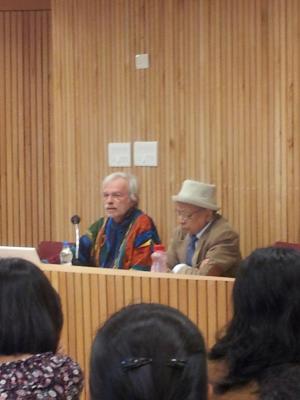As we commemorate the great poet Rabindranath Tagore on his 159th birth anniversary, it is remarkable how his works, to the present day, resonate with the harsh truths of the world at large and the deepest desires of the heart.
“My debts are large, my failures great, my shame secret and heavy; yet I come to ask for my good, I quake in fear lest my prayer be granted.”
Poem 28, Gitanjali (1912)
It is no shocker that Rabindranath Tagore, also known by his pen name Bhanu Singha Thakur, was one of the most exceptional literary laureates our world has been blessed with. A poet, novelist, musician, artist, educationist, social reformer, Ayurveda researcher; Tagore’s unparalleled brilliance earned him sobriquets like Gurudev, Kabiguru, and Biswakabi.
He has achieved many accolades in his lifetime – the most substantial being the first non-European to win the Nobel Prize for Literature. He also has the distinction of the only person to have composed the national anthems of three countries – India, Bangladesh, and Sri Lanka.
His excellence is most reflected in his literary works that still amaze and entertain people of all ages and diverse walks of life. Children’s stories like Kabuliwala, The Rat’s Feast, The Invention of Shoes, The Parrot’s Training, and so on are delightful and amusing. On reading them one gets lost in the ‘fantastically real worlds’ of sparkling kings and queens, dusty lanes of the village and, swirly, narrow streets of the city.
As one gets older, the stories of Tarapada in Atithi, the poignant tale of Konkaal (The Skeleton), the unbridled attachment of Monimala to her gold jewels in Monihara (The Lost Jewels), the sweet romance in Daliya and many more; pluck those chords of the heart, which transpire the emotions one had been starved of in the hustle-bustle of life. In all of his stories, the way he knits the real face of the society with myths and legends is extraordinary.
Tagore is also highly admired for his portrayal of women in his stories. Set in the late 19th and early 20th-century pre-partitioned Bengal, the female characters are painted as courageous, defiant, and bold who direct the flow of their lives on their terms. In a conservative society, Tagore explores love and sexuality through ‘Binodini’ in Chokher Bali (A Grain of Sand), freeing one’s soul and desires from the shackles of family and responsibilities in Stir Patra (Wife’s letter), courage to discover oneself and fulfill dreams in the form of ‘Giribala’ in Maanbhanjan (Fury Appeased) and finding the meaning of life outside the bondages of an ideal member of the society through ‘Kalyani’ in Aparichita (The Unknown Woman).
Robi Thakur, as he is lovingly called by many of his admirers, was a poet first. The early influences of the artistic atmosphere in his house and his “favourite school” – nature; metamorphosed into beautiful verses of poetry. many of his poems were written as words for music and his book Gitabitan (“Garden of songs”), a collection of all 2,232 songs led to the genesis of a new genre of Bengali music known as ‘Rabindra Sangeet’.
A man of phenomenal literary and artistic accomplishments, Tagore has played a vital role in capturing the social, political, and artistic aura of India of his times. India’s first Prime Minister, Jawaharlal Nehru, wrote in Discovery of India, “More than any other Indian, he has helped to bring into harmony the ideals of the East and the West, and broadened the bases of Indian nationalism.”
Inspired by Vaishnava poets of medieval Bengal and the Bengali folk literature; the classical Indian heritage; and the modern European literary tradition, he took Bengali literature especially, to such great heights that his presence in Bengali social and cultural arena is undeniably manifested.
Buddhadeva Bose in ‘An Acre of Green Grass’ quoted, “The point is not that his writings run into a hundred thousand pages of print, covering every form and aspect of literature, though this matters: he is a source, a waterfall, flowing out in a hundred streams, a hundred rhythms, incessantly.”
Even after years of Robi Thakur leaving for heavenly abode, his artistic and aesthetic flair can still be experienced in his endearing poems, visionary stories, and other literary works, euphonious ‘Rabindra Sangeet’ and in the atoms of the peaceful neighbourhood of Shantiniketan.
May the flame of knowledge, love, humility, and spirituality kindled by him forever guide us all.
Featured Image Credits: Commons
Ipshika Ghosh


 Professor Didier Coste of Bordeaux University, France, conducted the seminar on “Indian Literature as Comparative Literature” at Bharati College on 14th January, 2013. Comparative literature is the study of literature and other cultural expressions across linguistic and cultural boundaries. Dr. Chandra Mohan, Secretary General of Comparative Literature Association of India, chaired the seminar that was attended by Students and teachers of B.A. English Honours.
Professor Didier Coste of Bordeaux University, France, conducted the seminar on “Indian Literature as Comparative Literature” at Bharati College on 14th January, 2013. Comparative literature is the study of literature and other cultural expressions across linguistic and cultural boundaries. Dr. Chandra Mohan, Secretary General of Comparative Literature Association of India, chaired the seminar that was attended by Students and teachers of B.A. English Honours.